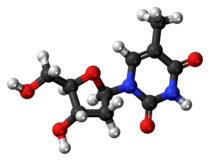Thymidine
 |
|
 |
|
| Names | |
|---|---|
| Other names
Td
|
|
| Identifiers | |
|
50-89-5 |
|
| 3D model (Jmol) | Interactive image |
| ChEMBL |
ChEMBL52609 |
| ChemSpider |
5585 |
| DrugBank |
DB04485 |
| ECHA InfoCard | 100.000.065 |
| 4718 | |
| MeSH | Thymidine |
| PubChem | 1134 |
| UNII |
VC2W18DGKR |
|
|
|
|
| Properties | |
| C10H14N2O5 | |
| Molar mass | 242.23 g·mol−1 |
| Melting point | 185 °C |
|
Except where otherwise noted, data are given for materials in their standard state (at 25 °C [77 °F], 100 kPa).
|
|
|
|
|
| Infobox references | |
Thymidine (deoxythymidine; other names deoxyribosylthymine, thymine deoxyriboside) is a pyrimidine deoxynucleoside. Deoxythymidine is the DNA nucleoside T, which pairs with deoxyadenosine (A) in double-stranded DNA. In cell biology it is used to synchronize the cells in G1/early S phase.
Before the boom in thymidine use caused by the need for thymidine in the production of the antiretroviral drug azidothymidine (AZT), much of the world's thymidine production came from herring sperm. Thymidine occurs almost exclusively in DNA but it also occurs in the T-loop of tRNA.
In its composition, deoxythymidine is a nucleoside composed of deoxyribose (a pentose sugar) joined to the pyrimidine base thymine.
Deoxythymidine can be phosphorylated with one, two or three phosphoric acid groups, creating dTMP (deoxythymidine monophosphate), dTDP, or dTTP (for the di- and tri- phosphates, respectively).
It exists in solid form as small white crystals or white crystalline powder. It has a molecular weight of 242.229 u and a melting point of 185 °C. The stability of deoxythymidine under standard temperature and pressure (STP) is very high.
...
Wikipedia
